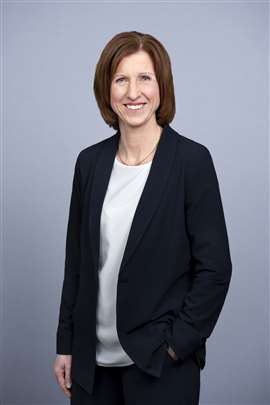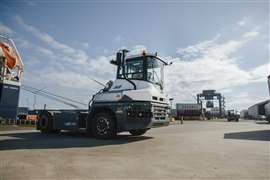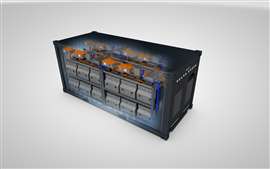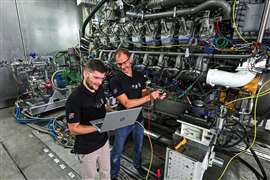Read this article in Français Deutsch Italiano Português Español
Executive Interview: Anna Müller, president, Volvo Penta
09 August 2024
 Anna Müller, Volvo Penta (Photo: Volvo Penta)
Anna Müller, Volvo Penta (Photo: Volvo Penta)
Anna Müller took over as president of Volvo Penta in December 2023. She replaced Heléne Mellquist, who left the Volvo Group to take a senior position at an investment firm. Müller first joined the Volvo Group in 2014, working in business development. From there, she was appointed senior vice president for Europe North and Central Division at Volvo Trucks before being selected for this latest role.
In an exclusive interview with Power Progress International, Müller started out by offering a review of company performance since she took over as president. “We’ve had a good start to the year, a good first quarter. But there has been a lot of getting to know the organisation, meeting customers and partners. We’ve been continuing to roll out our [emissions reduction] strategies, outlining where we want to be by 2030 and beyond.”
Müller immediately comes across as being highly dedicated to driving the business forward. Asked how the experience has been for her personally, she replies that her previous roles at the Volvo Group have stood her in good stead.
“I come from a background at Volvo Trucks; it’s not exactly the same, with the level of technology development here [at Volvo Penta]. But I was driving a sales organisation with about 3,000 people across northern Europe, selling about 24,000 trucks each year. So I wouldn’t say I’m either more or less busy, it’s just another type of complexity.”
As to the day-to-day of her role, whether that covers customer interactions or the quest for best practices and improved efficiencies, she has this to say: “I don’t think you can say ‘or’ with that question! ‘And’ would be more appropriate. I’m not putting deals together, but I’ve always loved to meet with customers. Of course, it’s also very important to focus on internal operations, communicate the direction needed to achieve our priorities.”
Emissions reductions
Volvo Penta has some ambitious emissions reductions targets. By 2030, the company is looking to cut emissions from plants and related logistics by 50%. By 2034, the goal is to reduce absolute emissions by 37.5% across operations, products and all transport.
Asked to give an update on these plans, Müller says they are still within reach. “As the Volvo Group, with Volvo Penta being a part of that, we have committed to the science-based targets (SBTs) outlined in the Paris Agreement [an international treaty on climate change adopted in 2015 covering mitigation, adaptation and financing to support emissions reduction strategies]. That means there are tough requirements for CO2 reduction.
“Right now, we are tracking according to our plan. It’s challenging, I think that’s the right way to describe it. We’re planning on using different levers to achieve these targets, as the Volvo Group and Volvo Penta. We’re working on several different technologies to deliver the necessary results.”
“I believe the customer comes first and that’s a very clear policy at the company”
Those technologies include continuing to improve internal combustion engine tech, while leveraging alternative fuels to reduce related emissions. There’s also continuing development of full electric and hybrid solutions, together with hydrogen fuel cells.
With that in mind, Müller says that it’s not the OEM working in isolation. “Everything is interdependent. As a society we all need to move forward. I fully subscribe to what Martin [Lundstedt, MD of Volvo] has said, in that partnership is the new leadership. We need to have partnership, but in a completely different way than before. It’s now about connecting all the different elements of society.”
 MOL electric terminal tractor at Ghent harbour; EVs will help Volvo Penta achieve emission reduction targets (Photo: Volvo Penta)
MOL electric terminal tractor at Ghent harbour; EVs will help Volvo Penta achieve emission reduction targets (Photo: Volvo Penta)
When asked about whether improvements to existing tech and the launch of new solutions will be sufficient to meet emissions reduction targets, or if outside factors such as carbon credits would be required, Müller had this to say.
“When you’ve subscribed to the science-based targets, you should be able to achieve those by yourself. We have committed to becoming a net-zero emissions company by 2050, which means we must transform our own operations and products. So, it’s up to us to develop the different technologies which deliver the necessary solutions,” she explains.
Looking at measuring the success of a given tech in reducing CO2e emissions, with improvements building towards the outlined target, Müller explains that the basic methodology is to compare the CO2 emissions of the product sales mix in 2019, the baseline year, with those of a later year. The difference in terms of total emissions delivers the rate of improvement.
“If I add an electric motor to what was a [standalone] diesel engine, improve the efficiency of that product over the 2019 baseline, then that will reduce overall emissions and take away from the total CO2 emissions produced over its working life and our SBT measure.”
In addition to performance improvements across the product portfolio, Volvo Penta is also looking to reach zero greenhouse gas emissions across its supply chain by 2050. Asked if there was anything the company could do to help support those reductions across Scope 3 activities, Müller replies: “It’s about partnership. Many of our suppliers have also committed to the SBTs. We have an on-going dialogue with those companies, which helps our alignment within the Volvo Group and how we carry out follow-up measurements.”
Battery power
One of the cornerstones of emissions reduction at Volvo Penta has been based on helping customers make the switch from internal combustion to battery-electric power. Yet despite the considerable investment, sales of battery-electric machines are still slow.
Müller, though, says that those numbers are still meeting expectations. “Of course, we would always like to see more sales, that’s the name of the game. But it’s still early days. What we can do is continue to offer battery solutions across as many applications as we can, deliver as many solutions to customers as we can. Honestly, I don’t think anyone expected us to be anywhere else than where we are right now [in terms of sales volumes].”
As part of that, she says that Volvo Penta has been learning from their counterparts at Volvo Trucks about electrification. But while that can help with fundamental application know-how, Müller states that the range of applications and the complexity of each solution delivered by Volvo Penta is a challenge beyond basic understanding of an electric drivetrain.
Sales of electrified products can be further supported by educating the customer as to how best use the new technology; the necessary changes to work cycles, etc.
“We’ve been working on this at Volvo Trucks, suggesting different driving styles to get the best range [from electric trucks], when to charge, etc. It all plays into a successful transition. The customer needs to know how to optimise their use pattern, in the harbour, in the field, or wherever the machine is operating,” she adds.
Market drivers
So far, local low-emissions regulations have been the primary driver behind battery-electric machine sales. Is it possible that in the future, basic market demand will take over, supported by more product knowledge?
 Battery electric storage systems raise the efficiency of microgrids (Photo: Volvo Penta)
Battery electric storage systems raise the efficiency of microgrids (Photo: Volvo Penta)
“OEMs and their customers need to invest a lot to change technology. We need the authorities to support us in that process. Regulations, incentives, these can all support that. Society and governments have to support the energy transition and move forward together.
“We’re still only at the start of the technology market transformation – we’ve still only just presented the first solutions to our customers,” she explains. “We’ve had more than 100 years of diesel engine development and only 10 or 15 years to make the shift to new, low-emission solutions. This transformation is ongoing.”
Together with the push for emissions reductions, Volvo Penta has also targeted a ‘zero accidents’ future. While this would likely remove the human operator from the machine, Müller says that autonomy can take many forms.
“We’re working with different types of autonomy across the Volvo Group. At the ACT Expo [in May] Volvo Autonomous Solutions launched the VNL Autonomous truck. But there are different levels of autonomy; not all mean that there’s no operator in the cab. Instead, the systems support the operator in various ways. I think the assisted docking feature we offer through the Marine division is a perfect example of that.”
Taking that one step further, Müller is asked about whether Volvo Penta has been able to successfully leverage AI in development of new features and tech. With a polite laugh, she respectfully declines to offer any related details, other than to say the company has been looking into ways the tech could be used.
To round out the conversation, Müller was asked about how well her own views on technology development aligned with those of Volvo Penta. “I think it’s a very good match. I believe the customer comes first and that’s a very clear policy at the company. I firmly believe in achieving improved sustainability and achieving that is a key part of my role as company leader.”
POWER SOURCING GUIDE
The trusted reference and buyer’s guide for 83 years
The original “desktop search engine,” guiding nearly 10,000 users in more than 90 countries it is the primary reference for specifications and details on all the components that go into engine systems.
Visit Now
STAY CONNECTED




Receive the information you need when you need it through our world-leading magazines, newsletters and daily briefings.
CONNECT WITH THE TEAM













